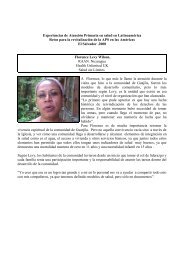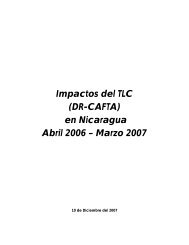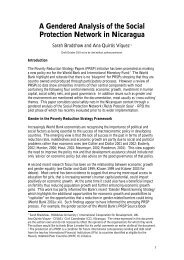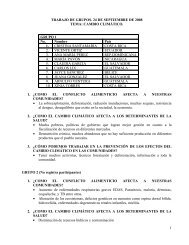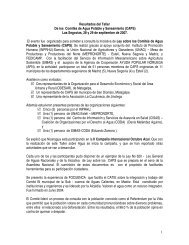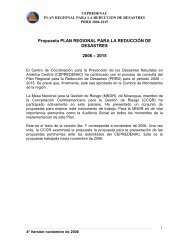Download - CISAS | Centro de Información y Servicios de AsesorÃa ...
Download - CISAS | Centro de Información y Servicios de AsesorÃa ...
Download - CISAS | Centro de Información y Servicios de AsesorÃa ...
Create successful ePaper yourself
Turn your PDF publications into a flip-book with our unique Google optimized e-Paper software.
INFORME ALTERNATIVO SOBRE LA SALUD EN AMERICA LATINAsocial and political history. In or<strong>de</strong>r pinpoint the causesthat have led to the long term crisis that the regioncurrently faces.We will analyze the recent the capitalistaccumulation system and the economic historyof Latin America.From the imports substitution mo<strong>de</strong>l tothe secondary exportation mo<strong>de</strong>lThe imports substitution mo<strong>de</strong>l arose in the periodbetween World Wars I and II. It placed industrial<strong>de</strong>velopment as the axis of capital accumulation, butsoon certain structural limits of the economical mo<strong>de</strong>lbecame evi<strong>de</strong>nt in the 60’s: an increasing payments<strong>de</strong>ficit, resulting from weak industrial nationalintegration; the elevated external <strong>de</strong>bt; the increaseof inflation; and the low productivity of the productioninfrastructure. Even so, structural economic problemswere masked for almost two <strong>de</strong>ca<strong>de</strong>s, by an aggressivecredit system and from rising prices of rawmaterial produced by the countries. Nonetheless,two external events have ignited the abrupt reappearanceof the socio-economical crisis of the 80’s, notallowing economies to sustain their growth. High interestrates have led to the reduction of internal credit,and secondly, the increase of the external <strong>de</strong>bt ofthe zone and the collapse of the cost of raw materialfor export, such as coffee, sugar and petroleum. Economiescame to a standstill: external credit was suspen<strong>de</strong>d,and capital received by means of raw materialand primary products exportation <strong>de</strong>creasedconsi<strong>de</strong>rably.This un<strong>de</strong>rmined the capacity for importingthe intermediate and capital goods that the economicapparatus <strong>de</strong>man<strong>de</strong>d.The financial effects didn’ttake long to become evi<strong>de</strong>nt including the flight offinancial resources, <strong>de</strong>valuation, interest rates increase,<strong>de</strong>creased credit, and <strong>de</strong>ficit in the balance of capital.The insertion of Latin America intothe global marketIn view of the manifest crisis of the imports substitutionmo<strong>de</strong>l, Latin-American governments gave wayto a new pattern of capital accumulation, based on theimpulse of the secondary exports sector, which correspon<strong>de</strong>dto the new trends of international capital.Actually, this implied a direct tie of the region to globaleconomy and to the new profit strategies of nationalenterprises and large transnational corporations.This is how neoliberal economical policies wereimposed in Latin America.These policies were maintainedor ratified even in countries where there hadbeen political transitions from military to civil governments,as in Brazil, Argentina, Chile and Uruguay. Notto mention authoritarian governments, like in the Mexico,which had already signed the first letter of intentwith the International Monetary Fund in 1977. In it, theMexican state ma<strong>de</strong> the commitment to adopt austereeconomical policies.These policies were postponeduntil 1982, due to the momentary economic relieffrom the "oil boom".The neoliberal economic policies and the globalcapital market strategies have aimed at making theeconomical structures of countries suitable to the necessitiesof large capital investment. It is since the crisisof Latin-American external <strong>de</strong>bt, during the early80’s, that generalized measures have been imposed onthe countries of the region: opening of internal marketsto external competition; the privatization of publiccompanies; the liberalization of investment policies,not only the direct foreign investment (IED), butalso the portfolio or speculative investments; the liberalizationof financial systems; the diminished State’srole in the economy; and the imposition of labor flexibilizationon companies.In sight of the financial crisis of the 80’s, the Latin-Americangovernments applied shock plans to sta-92





